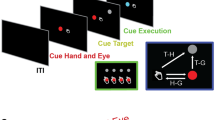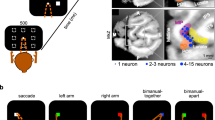Abstract
Many voluntary movements involve coordination between the limbs1,2. However, there have been very few attempts to study the neuronal mechanisms that mediate this coordination. Here we have studied the activity of cortical neurons while monkeys performed tasks that required coordination between the two arms. We found that most neurons in the primary motor cortex (MI) show activity specific to bimanual movements (bimanual-related activity), which is strikingly different from the activity of the same neurons during unimanual movements. Moreover, units in the supplementary motor area (SMA; the area of cortex most often associated with bimanual coordination3) showed no more bimanual-related activity than units in MI. Our results challenge the classic view that MI controls the contralateral (opposite) side of the body and that SMA is responsible for the coordination of the arms. Rather, our data suggest that both cortical areas share the control of bilateral coordination.
This is a preview of subscription content, access via your institution
Access options
Subscribe to this journal
Receive 51 print issues and online access
$199.00 per year
only $3.90 per issue
Buy this article
- Purchase on Springer Link
- Instant access to full article PDF
Prices may be subject to local taxes which are calculated during checkout




Similar content being viewed by others
References
Kelso, J. A. S., Southard, D. L. & Goodman, D. On the coordination of two-handed movements. J. Exp. Psychol. Hum. Percept. Perform. 5, 229–238 (1979).
Franz, E. A., Zelaznik, H. N. & McCabe, G. Spatial topological constraints in a bimanual task. Acta Psychol. 77, 137–151 (1991).
Wiesendanger, M. in Role of the Cerebellum and Basal Ganglia in Voluntary Movement (eds Mano, N., Hamada, I. & DeLong, M. R.) 253–266 (Elsevier, Amsterdam, 1993).
Wiesendanger, M., Rouiller, E. M., Kazennikov, O. & Perrig, S. Is the supplementary motor area a bilaterally organized system? Adv. Neurol. 70, 85–93 (1996).
Brinkman, C. Supplementary motor area of the monkey's cerebral cortex: short- and long-term deficits after unilateral ablation and the effects of subsequent callosal section. J. Neurosci. 4, 918–929 (1984).
Brinkman, C. & Porter, R. Supplementary motor area in the monkey: activity of neurons during performance of a learned motor task. J. Neurophiol. 42, 681–709 (1979).
Karol, E. A. & Pandya, D. N. The distribution of the corpus callosum in the rhesus monkey. Brain 94, 471–486 (1971).
Tokuno, H. & Tanji, J. Input organization of distal and proximal forelimb areas in the monkey primary motor cortex: a retrograde double labeling study. J. Comp. Neurol. 33, 199–209 (1993).
Luppino, G., Matelli, M., Camarda, R. & Rizzolatti, G. Corticocortical connections of area F3 (SMA-proper) and area F6 (pre-SMA) in the macaque monkey. J. Comp. Neurol. 338, 114–140 (1993).
Lecas, J. C., Requin, J., Anger, C. & Vitton, N. Changes in neuronal activity of the monkey precentral cortex during preparation for movement. J. Neurophysiol. 56, 1680–1702 (1986).
Crammond, D. J. & Kalaska, J. F. Preparatory neuronal activity in premotor cortex during an instructed-delay period: relation to contra and ipsilateral arm movements. Soc. Neurosci. Abstr. 17, 308–308 (1991).
Perepelkin, P. D. & Schwartz, A. B. Simultaneous populations of single-cell activity recorded bilaterally in primate motor cortex. Soc. Neurosci. Abstr. 22, 2022–2022 (1996).
Tanji, J., Okano, K. & Sato, K. C. Relation of neurons in the nonprimary motor cortex to bilateral hand movement. Nature 327, 618–620 (1987).
Tanji, J., Kazuhiko, O. & Kazuko, C. S. Neuronal activity in cortical motor areas related to ipsilateral, contralateral, and bilateral digit movements of the monkey. J. Neurophysiol. 60, 325–343 (1988).
Kim, S. G.et al. Functional magnetic resonance imaging of motor cortex: hemispheric asymmetry and handedness. Science 261, 615–617 (1993).
Brinkman, J. & Kuypers, G. J. M. Cerebral control of contralateral and ipsilateral arm, hand and finger movements in the split-brain rhesus monkey. Brain 96, 653–674 (1973).
Jenny, A. B. Commissural projections of the cortical hand motor area in monkeys. J. Comp. Neurol. 188, 137–145 (1979).
Muakkassa, K. F. & Strick, L. Frontal lobe inputs to primate motor cortex: evidence for four somatotopically organized ‘premotor’ areas. Brain Res. 177, 176–182 (1979).
Jones, E. G. in Cerebral Cortex (eds Jones, E. G. & Peters, A.) 113–183 (Plenum, New York, 1986).
Rouiller, E. M.et al. Transcallosal connections of the distal forelimb representations of the primary and supplementary motor cortical areas in macaque monkeys. Exp. Brain Res. 102, 227–243 (1994).
Evarts, E. V. Relation of pyramidal tract activity to force exerted during voluntary movement. J. Neurophysiol. 31, 14–27 (1968).
Scott, S. H. Comparison of onset time and magnitude of activity for proximal arm muscles and motor cortical cells before reaching movements. J. Neurophysiol. 77, 1016–1022 (1997).
Georgopoulos, A. P., Ashe, J., Smyrnis, N. & Taira, M. The motor cortex and the coding of force. Science 256, 1692–1695 (1992).
Schwartz, A. B. Direct cortical representation of drawing. Science 265, 540–542 (1994).
Taira, M., Boline, J., Smyrnis, N., Georgopoulos, A. P. & Ashe, J. On the relations between single cell activity in the motor cortex and the direction and magnitude of three-dimensional static isometric force. Exp. Brain Res. 109, 367–376 (1996).
Donchin, O., Gribova, A., Bergman, H. & Vaadia, E. How do the two hemispheres of the cortex communicate in coordinating the actions of the arms: single unit study in a behaving monkey. Soc. Neurosci. Abstr. 22, 2022–2022 (1996).
Roelfsema, P. R., Engel, A. K., Konig, P. & Singer, W. Visuomotor integration is associated with zero time-lag synchronization among cortical areas. Nature 385, 157–161 (1997).
Murthy, V. N. & Fetz, E. E. Synchronization of neurons during local field potential oscillations in sensorimotor cortex of awake monkeys. J. Neurophysiol. 76, 3968–3982 (1996).
Georgopoulos, A. P., Kalaska, J. F., Caminiti, R. & Massey, J. T. On the relations between the direction of two-dimensional arm movements and cell discharge in primate motor cortex. J. Neurosci. 2, 1527–1537 (1982).
Matsuzaka, Y., Aizawa, H. & Tanji, J. Amotor area rostral to the supplementary motor area (presupplementary motor area) in the monkey: neuronal activity during a learned motor task. J. Neurophysiol. 68, 653–662 (1992).
Acknowledgements
We thank S. P. Wise and J. Kalaska for their comments on earlier versions of the manuscript; A. P. Mitz for contributions to the style and content of the work; Y. Donchin for help during the surgical procedures; and the Clore Foundation for the fellowship that supported O.D. throughout this project. This research is supported in part by a grant from the US-Israel Binational Foundation and by a grant from the Israel Science Foundation.
Author information
Authors and Affiliations
Corresponding author
Rights and permissions
About this article
Cite this article
Donchin, O., Gribova, A., Steinberg, O. et al. Primary motor cortex is involved in bimanual coordination. Nature 395, 274–278 (1998). https://doi.org/10.1038/26220
Received:
Accepted:
Issue Date:
DOI: https://doi.org/10.1038/26220
This article is cited by
-
Effects of transcranial direct current stimulation over human motor cortex on cognitive-motor and sensory-motor functions
Scientific Reports (2023)
-
Local field potentials in the parietal reach region reveal mechanisms of bimanual coordination
Nature Communications (2021)
-
Left hemisphere damage produces deficits in predictive control of bilateral coordination
Experimental Brain Research (2020)
-
Changes in ipsilesional hand motor function differ after unilateral injury to frontal versus frontoparietal cortices in Macaca mulatta
Experimental Brain Research (2020)
-
Bimanual coordination deficits in hands following stroke and their relationship with motor and functional performance
Journal of NeuroEngineering and Rehabilitation (2019)
Comments
By submitting a comment you agree to abide by our Terms and Community Guidelines. If you find something abusive or that does not comply with our terms or guidelines please flag it as inappropriate.



